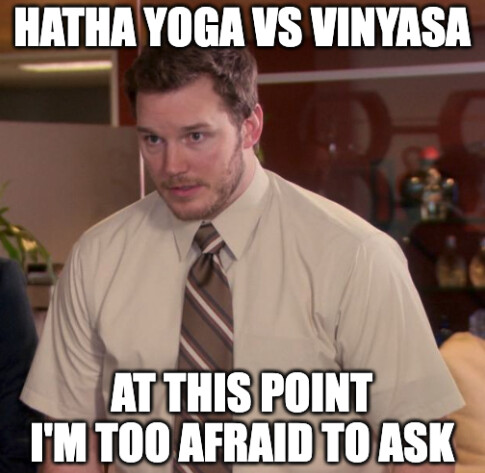So I’ve been practicing for about half a year now and honestly, I’m still puzzled about where Hatha ends and Vinyasa begins.
Some instructors tell me Vinyasa is basically Hatha in motion, while others treat them like they’re from different planets entirely. The more I read online, the more confused I get because every website seems to have its own interpretation, and I’d really love to hear from fellow yogis about how you understand these styles.
Maybe I’m overthinking it, but I feel like understanding the distinction would help me choose classes more intentionally rather than just wandering into whatever’s on the schedule.
11 Likes
Deepen Your Practice Beyond the Mat
Finding meaningful yoga discussions and guidance can be surprisingly difficult. Discover a space where your questions are welcomed and your growth is celebrated: Start Your Journey
Oh, so from what I understand, Hatha is basically the umbrella term for all the physical stuff we do in yoga, like all those poses and stretches.
Vinyasa is when you kind of flow from one pose to another? Like when the instructor has you moving smoothly between positions instead of just holding them separately. It feels almost fluid sometimes. The thing that surprised me about Hatha classes is they can be SO different from each other.
I’ve been to some where we barely break a sweat and just hold gentle stretches, and others where I’m shaking and wondering if I’ll make it through. Really depends on the teacher, I guess? Vinyasa classes seem to keep you moving pretty much the whole time, lots of transitioning and flowing. My heart definitely gets pumping in those! Hope that makes sense.
Still figuring all these terms out myself but that’s what I’ve gathered so far.
People think Vinyasa is some kind of Olympic-speed yoga race. I’m so tired of people assuming that just because it’s Vinyasa, you’re going to be whipping through poses like you’re trying to win a medal.
Some of the most powerful Vinyasa classes I’ve taken moved at a snail’s pace! We held maybe five poses the entire hour, but the way we flowed between them with our breath? Chef’s kiss THAT’S what Vinyasa is actually about- linking breath to movement, not turning yourself into a human blur. Stop spreading this ‘Vinyasa = cardio yoga’ nonsense!
In Hatha, we surrender to the sacred stillness, allowing our bodies to melt deeply into each asana as time becomes fluid and breath becomes prayer. Each pose becomes a meditation, a gentle conversation between body and spirit.
Vinyasa flows like a river of consciousness, each breath birthing a new movement, creating a divine flow where inhale and exhale guide us through an endless stream of transformation.
It’s poetry in motion, where breath and body unite as one.
I hope you’re finding balance in your practice! In Hatha, there’s such a beautiful emphasis on discovering the interplay between opposing energies within each posture. When you settle into warrior two, notice how you can root deeply through your lower body while simultaneously feeling that gentle rise through your spine and crown, it’s like becoming a bridge between earth and sky.
Mountain pose is another lovely example of this harmony, as your front body opens and lifts, your back body grounds and settles, creating a sense of wholeness. Vinyasa tends to flow more continuously between poses, which can be wonderful too, though in a different way.
Whatever path you choose, may it serve your body and spirit well.
I went to a vinyasa class last week where they were playing EDM remixes and I’m trying to find my breath but all I can hear is untz untz untz.
Look, I get that vinyasa has more energy than hatha, but when did yoga become a rave? Give me those quiet hatha classes with maybe some soft instrumental music any day. At least in hatha, nobody’s trying to make you do 47 chaturangas while Pitbull tells you about Miami.
When I go to Hatha classes, we tend to hold poses longer and really focus on getting the alignment just right, it’s like each posture is its own little meditation. In Vinyasa classes though, there’s this beautiful rhythm where we’re constantly flowing from one pose to the next and the transitions themselves become just as important as the poses.
Both styles use the same poses and link breath to movement, but Hatha feels more like practicing individual notes while Vinyasa is playing the whole song.
If you want to experience both worlds in one session, look for a Hatha Flow class.
It combines the alignment focus of Hatha (alignment precision: 9/10) with some of the flowing elements of Vinyasa, giving you a bit of both styles. The balance between stillness and movement? A solid 8/10. Perfect for those who can’t decide between the two. though wait until you discover what happens when you add heated rooms to the mix. But that’s a story for another day.
If you’re finding the distinctions blurry after half a year of practice, then you might benefit from experiencing how different teachers interpret these styles,
Each studio (and teacher within those studios even) seems to have its own ‘flavor’ of what makes something hatha versus vinyasa. When I was confused like you, seeing side-by-side comparisons really helped me understand that if a class emphasizes staying in poses to build strength and awareness, it tends to lean towards hatha, but if it’s about creating heat through continuous movement, then it’s more vinyasa-oriented.
There’s a breakdown that shows how the same sequence can be taught both ways, which totally changed how I approach choosing classes. If I want to work on flexibility and meditation, I go hatha, but if I need to burn off energy and get my heart rate up, then vinyasa is my go-to.

